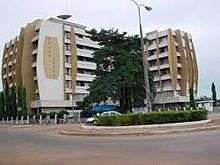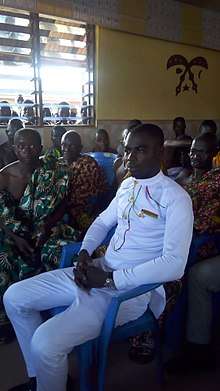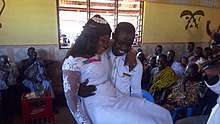Seikwa B/A
Seikwa is a town located in the Brong Ahafo Region of Ghana, Tain District.

History
The people of Seikwa were said to have migrated from Dafupeji in Bouna in the Ivory Coast around the 1580s. Tradition says that the first monarch, Nana Kaka, married a woman from Bouna named Jofotia and gave birth to a son called Akrosoma. The son was famous for his bravery deeds and through that he assumed the leadership of his fathers whole army.
The people experience frequent wars around that area, so they decided to migrate to Kumasi to join their brothers the Ashantis, for safety and protection. Some of the people were undecided, but majority agreed, so they set off. Ontheir way, they came to a place called Angenye. They settled here for some period with the view of waiting for the rest of the family members from Nasana.
The story goes on to indicate that the people move to a place called Yerekae in 1682 in the Gyaman land. the only lady (Obaapanim) of the family by name Nana Davunsee was old and weak so she died. Yerekae literary means the old lady could not continue. Some of the people were left to bury her at Yerekae while others moved on the Sampa.
When they came to Sampa there was war raging in Tonye near Banda between the Bandas and the Ashantis in the 1730s. The people of Ashantis cried to Nana Kaka for help. Akrosoma the well known warrior was elected to lead a great army which marched towards them and Akrosoma won the battle. The death of Nana Kaka was revealed to Akrosoma at tonye. Due to that Akrosoma committed suicide. This constitutes the present oath of the people. Nana Kaka died at sampa in 1731 and was succeeded by his nephew Kalimeh in 1731.
When Ashantehene (Nana Osei Tutu) heard of their bravery, he extended an invitation through Ampabamehene to bring the people to Kumasi. However some of the Seikwa (Nkrorans) people were left at Sampa to take care of the body of the first monarch, Nana Kaka. Nana Kalimeh in 1741 led the people through Nsoatre, Dominease Akropong in Ashanti.
From Akropong, they settled at Ampabame. After staying for sometime they went to Sargranti war of 1874 with the Ashantis against the British and became successful. After the war they came and settled at Amakom in Kumasi. The Obaapanim Afia BosompenyaaI, saw that her peoples were being used frequently for wars by the Ashantis. In her wisdom, therefore, she fabricated a story that she was not finding suitable chewing stick (pasogo). SHE Told Asantehene about it and convinced him that on their way to Kumasi they found a lot of suitable chewing trees in the Savanna areas, so they must be allowed to go back for some. Asantehene conceded to this idea and released Okyeame Banin to take them to the grassy land. they first settled at Akomadan, Nkenkansu and Techiman in 1875. From Techman they discovered river Nyamepene and followed it along the banks to Nkorankwagya near Nsawkaw.
In 1876, under Ekyi Kofi they came to Domyaa from Nkorankwagya. At Domyaa, there was misunderstanding between Nana Banin and his nephew (the Badu people) so they fought and fell apart. The Nkorans (Seikwa people) moved from Domyaa to Tomeanya (Tanokrom) meaning my own town. From Tomeanye they move to Domeabra. At Domeabra, there was drought so a certain hunter, Bofo Dabratia, in his hunting expedition saw a river, which was flowing from a mountain. He related the story to the than chief through Kyeame Brempon Banin and said in twi "ensuo yi da ho resee kwa" hence Seikwa. They move to the river bank and built a house near the bank. The house collapsed on two brothers of the chief. So they moved further away from the river bank to the present place (Seikwa town) in about 1877 under the able leadership of Nana Ekyi Kofi I.
Short History Of The Nana Kaka Stool
Name of the founder; Nana Kaka (1580s). The original home of the stool; Dafupeji in bouna in Ivory Coast.
Chronology Of Previous Chiefs
1.Nana Kaka 1580-1731
2.Nana Kalimeh 1731-1752
3.Nana Kumah 1752-1777
4.Nana Agyei 1777-1828
5.Nana Juma 1828-1857
6.Nana Ekyi Kofi 1857-1877
7.Nana Kwasi Bekoe I 1877-1943
8.Nana Kwasi Bekoe II 1943-1954
9.Nana Kwasi Kra III 1954-1960
10.Nana Kwasi Bekoe Ababio 1960-1985
11.Nana Kwaku Dwuma Ankoana II 1985-2013
Population
The Seikwa has a population size of 9,166 as at 2010 with males being 4,149 and females being 5,017 (Source: Ghana Statistical Service[1] –Population Estimates for Brong Ahafo Region-2010).
Festival
Seikwa celebrates the annual Yam festival in September/October. The climax of the Yam festival is the durbar of the king (Omanhene) through Seikwa traditional area. it marks the harvesting of the yam in the town of Seikwa and its neighbours.
Education
Seikwa is known by the reputable institutions, Seikwa Nursing and Midwifery Training School, Nkoranman Senior High and many other Junior High Schools.
Health
Seikwa has only two clinics, one public and the other one owned by madam Nyarko.
Road Network
The road linking Seikwa to Berekum is 70% tied but Seikwa to Nsawkaw, Seikwa to Sampa are untied
Sports
The inhabitants of Seikwa are sports fanatics; many residents of Seikwa traditional area follows the Seikwa-based sports team, Nkoranman United which is owned by Nana Kwasi Kobire and Seikwa Young Arsenals, which is currently playing in the second division league.
Notable people
Seikwa is the home and birthplace of Hon.Johnson Asiedu Nketia (General Mosquito) the current general secretary of National Democratic Congress (NDC)Emmanuel Agyeman Badu footballer. Hon.Jones Tewiah Former District Chief Executive (DCE)Tain district, The late Lawyer Obeng Manu, Nana Kwasi Kobere (Nkosoohene) and many others.
Banking System
Seikwa has only one bank which is for the community Nkoranman Rural bank.
Pictures of Seikwa




security service
The community has one police station, with about seven police officers. And about six fire service personnels with one fire tender which serves the community. And about six customs officers.
Villages Surrounding Seikwa
The following villages can be locate at Seikwa; Tainso, Nkwanta, Kyekyere. Bepoase, Tannokrom, Nasana, Atomfooso, Degedege, Asiakrom, Konkonte, Adadease, koogbega, Aboosu,Amangoase, Babakrom,Kwadwoakoh, Tiadenne and many others.
Communication Service
The town of Seikwa is outfitted with modern communication facilities which include, mobile phones, internet and e-mail services. All these services are provided courtesy of the following giant telecommunication network providers, MTN Ghana, Airtel Ghana, Vodafone Ghana and Tigo Ghana.
Occupation
Agriculture is the main occupation among the workforce of Seikwa. And their best food is fufu(Doyoogo). Example of crops produce by the people of Seikwa are; Yam, Cashew, Pepper, Groundnuts, Maize, Cassava and many others.